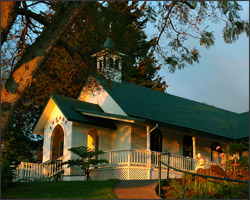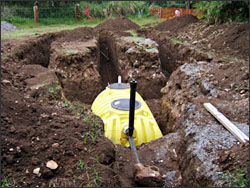Contact EPA Pacific Southwest Water Division
Pacific Southwest, Region 9
Serving: Arizona, California, Hawaii, Nevada, Pacific Islands, Tribal Nations
Hawaii Cesspools
| Underground Injection Control (UIC) Quick Finder | ||
|---|---|---|
| Ground Water HomeUIC Home | Cesspools in HawaiiClass V Wells | UIC PermitsOnsite Sewage Treatment |

Success Stories
St. John’s Episcopal Church
Keokea, Maui, Hawaii
Bill Bates, Junior Warden
Along with complying with federal law, Mr. Bates recognized the importance of closing the Church’s cesspool. “When you look at the purpose of what EPA’s doing, it’s long range, it’s looking for the future of Hawaii’s children and families; we just can’t keep on polluting our soil and eventually our water systems, therefore it’s meaningful that we do comply with the mandate.” HDOH provided Mr. Bates with a list of local engineering firms and was recommended a few firms through the “coconut wireless.” Mr. Bates was looking for an engineer familiar with designing septic systems, obtaining the correct permits and dealing with the various federal, state and local rules. Armed with information on these local engineers, Mr. Bates lead meetings detailing the options to the Church’s different committees and eventually obtained approval from the Diocese’s Bishop, to contract with Linda Taylor Engineering, Inc.

“Develop an immediate rapport with EPA officials, it does not hurt to pick up the phone and discuss your individual challenges…"
Grass is slowly coming over the leach field and the Church grounds are returning to normal post-construction. Mr. Bates’ hard work, diligence and commitment to his Church and this project are an excellent example of successfully closing a cesspool. When asked if he had any advice to pass on to others in a similar situation, Mr. Bates had a few very important words of wisdom, “Develop an immediate rapport with EPA officials, it does not hurt to pick up the phone and discuss your individual challenges…you’ll find that [EPA] is very receptive, it’s a very smart thing to do. Submit progress reports; follow your [compliance] timeline, so that there’s no guess-work. Furthermore, I would be patient dealing with extremely busy contractors, the weather; don’t get frustrated and really look into who you’re working with...Try and get an understanding of septic systems and leach fields, it doesn’t hurt [to know] the terminology.”
Carol Yamamura
Hawaii Resident, Home and Cottage
Carol Yamamura took action after reading about the large capacity cesspool ban in the Maui News; realizing the ban applied to the cesspool for her house and cottage. She updated her home’s wastewater system, not only to comply with the new law, but also to protect the environment.
Initially, Ms. Yamamura didn’t know how to get information on closing her cesspool. “I didn’t know where to go or the steps I had to take; the public needs to be educated on [the steps you need to take to close a cesspool].” Ms. Yamamura turned to her friends and neighbors to get the help and information she needed. Fortunately, once she found out what to do, the process went smoothly with few complications.
“I decided to do it on my own; it wasn’t like I was told to do it.”
To begin with, Ms. Yamamura hired Linda Taylor Engineering, Inc. The engineer came to her home and determined that Ms. Yamamura needed an excavator. The engineer and excavator drew up plans for cesspool conversion and the plans were sent to HDOH for a permit to use the existing cesspool as a seepage pit for a septic system.
It took Ms. Yamamura only four months (November 2005 - February 2006) to complete her cesspool conversion and septic tank installation, despite the unique shape of her property and the engineering challenges it posed, whereby a leach field could not be installed. “The engineer said it was one of the worst properties he ever saw.”
When asked what advice she would give to others in a similar situation, Ms. Yamamura said, home owners should get it done now. In addition, working with a reputable engineer and excavator were very important in the process and Ms. Yamamura cautioned to choose a reputable engineer.
